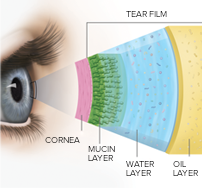Is Omega-3 the Final Answer to Your Dry Eye Problems?
Mar 09, 2021

Michelle Tran is a 4th year optometry student with a passion for dry eyes. She has dry eyes herself and is constantly looking for the best remedies for herself and her patients. Follow Michelle Tran on Instagram @shelletran for any questions and awesome optometry content!
A few of the tried and true first-line treatment options for dry eye include using artificial tears, warm compresses, and lid scrubs. Among these first-line treatment options is increasing the amount of omega-3 fatty acids through your diet or supplementation. You might’ve heard the term “omega-3” thrown around a lot in dry eye, but does it truly make a difference?
Dry Eyes
Blinking is so essential to our ocular health and to maintain a lubricated front ocular surface for clear and comfortable vision. Each time we blink, our eyes are freshly coated with a new tear film composed of a harmonious mix of mucin, water, and oil. Any absence or off-balance ratio of these three components can contribute to dry eyes and eventual damage to the front ocular surface causing symptoms like burning, stinging, inflammation, or blurry vision.
How does fish oil play a role in dry eyes?
Fish oil is extracted from fatty fish like salmon or mackerel. It’s composed of two types of omega-3 fatty acids: docosahexaenoic acid (DHA) and eicosapentaenoic acid (EPA). DHA and EPA have anti-inflammatory properties which fight against dry eyes.
Omega-3 contributes to increasing the oil layer in the tear film, keeping the surface of the eye lubricated for longer. Omega-3 also reduces inflammation which is one of the main mechanisms that causes dry eye in the first place.
How to increase the amount of omega-3 in our system?
The American Heart Association recommends eating at least 2 servings of fish, especially fatty-fish, per week. One serving of fish is about 3.5 ounces cooked. These are types of fish to incorporate in your diet that provide sources of DHA and EPA in omega-3:
- salmon
- albacore tuna
- mackerel
- herring
- sardines
Although increasing the amount of omega-3 directly through the diet is one of the most preferred ways, increasing omega-3 through supplementation may be a great alternative if you aren’t able to consume fatty fish because it’s inaccessible or you don’t find it palatable.
HydroEye is a dry eye supplement that’s been through scientific research and has been clinically shown to improve dry eye symptoms. HydroEye contains the DHA and EPA components found in omega-3 fatty acids to improve our tear film production.
This supplement also contains GLA which is an omega-6 fatty acid that has been found to be great for dry eyes for its complementary role to DHA and EPA. A double-blind, placebo-controlled, multi-center trial showed that HydroEye reduced dry eye symptoms of irritation and discomfort while improving the health appearance of the ocular surface.
Fish Oils on the Market
Reading labels is crucial to choosing the omega-3 supplements that will actually make a difference in your dry eye treatment because not all fish oils are created equally.
Look for supplements that give you 1,000-3,000mg of EPA, DHA, and GLA combined per serving. Make sure to discuss proper dosages with your doctor prior to increasing omega-3 fatty acids into your lifestyle especially if you are at risk for blood clotting disorders.
So, the bottom line is that omega-3 fatty acids do play an important role in managing dry eyes. Whether you’re getting the appropriate amount of omega-3 directly through your diet or through supplementation, you’re definitely taking the appropriate step in the right direction to eradicate your dry eye symptoms once and for all.
Remember that, like with most things, this is a gradual process and your dry eye symptoms won’t be solved overnight. Continue your dry eye regimen and increase omega-3 fatty acids in your body if you haven’t already. Stay consistent now and experience the health benefits for life.
Bonus: Other Nutrients Beneficial to the Tear Film
Vitamin C is another great vitamin that helps with dry eyes. Vitamin C plays an important role in the tear film and helps fight oxidative stress, one of the mechanisms behind dry eye.
Our body does not make Vitamin C on its own and needs to be consumed through diet or supplementation. Great sources of Vitamin C include:
- strawberries
- oranges
- grapefruit
- broccoli
- red bell peppers





